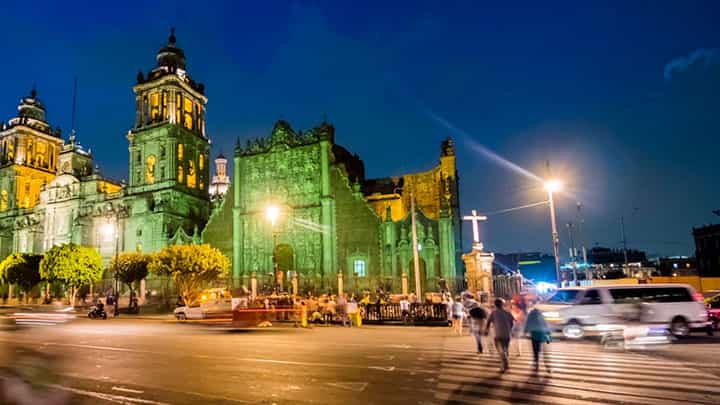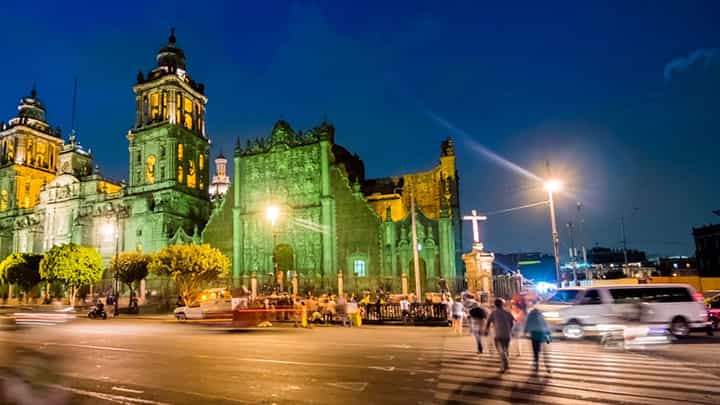
A New American Moment
Construction of the controversial Mexico—U.S. Barrier Wall has begun. Contributor DYLAN SMITH explores how DACA, Dreamers and Governor Brian Sandoval are informing the New American Moment.


KornFerry.com
Dylan Smith
2020-01-01
2020-01-01
Empire
https://www.charlatanmagazine.com/Columns/Empire/
Night falls on Mexico City’s Historic Center, and from a rooftop bar I can see the city’s cultural past and present in a single panoramic shot. The Latin-American Tower twinkles like the New York City skyline. The Metropolitan Cathedral was consecrated in 1656 by the Spanish Empire, and the Ottomon Clock was donated by the Arab Community living in Mexico in 1910. Each are transnational expressions of immigrant identity.
The Plaza de la Constitución, the country’s National Palace, begins to glow on the now United Mexican States. Their 57th President, Enrique Peña Nieto, prepares to address the Mexico-United States Diplomatic Crisis. Upon my descent into Mexico City, U.S. President Donald Trump was tweeting: "Our Border Laws are very weak while those of Mexico & Canada are very strong. Congress must change these Obama era, and other, laws NOW! The Democrats stand in our way: they want people to pour into our country unchecked....CRIME! We will be taking strong action today.” Later, he told reporters aboard Air Force One, “Until we can have a wall and proper security, we're going to be guarding our border with the military.”
The tweets and press release followed the approval of a $1.3 trillion Federal Spending Bill that allocated $1.6 billion toward the new Mexico-U.S. Barrier Wall, and a surreal, if harrowing year of threats to withdraw from the North Atlantic Free Trade Agreement.
Peña Nieto broke his silence, speaking directly to President Trump, from the National Palace. “President Trump, if you wish to reach agreements with Mexico, we stand ready, as we have proved until now, always willing to engage in a dialogue, acting in earnestness, in good faith and in a constructive spirit.”
The President of the United States does not have the power to deploy the National Guard alone. Each of the 54 organizations fall under two jurisdictions: the federal government and the state. While Arizona, New Mexico, and Texas have cooperated, California and Oregon demurred. Then, of course, there were the others. Republicans. With far more at stake.
Nevada Governor Brian Sandoval says “I don’t think deploying troops would be an appropriate use of the Nevada National Guard,” indicating that he would decline to deploy their nearly 4000 soldiers and airmen if asked to do so by the President.
As a Hispanic American with Latino roots, Brian Sandoval finds himself in the crosshairs of Trump’s war on immigrants, his final year as Governor of Nevada, and the very crossroads of American politics. Sorting an impulsive foreign policy for a coherent worldview, each of these men stands shoulder-to-shoulder much like the Cathedral, Financial Tower, and Palace. Together, they’re the metaphorical standard bearers of the New American Moment.Mexico-U.S. Barrier Wall
When nations construct boarder walls, their intention is to serve and protect themselves. The Great Wall of China, for instance, began as a series of small fortifications intended to defend themselves from the invasions of various nomadic groups in the Eurasian Steppe. Especially famous is the wall built in 220–206 BC by Qin Shi Huang, the first Emperor of China. Apart from defense, the Qin Dynasty’s Great Wall included border controls. Imposing duties, tariffs and taxes on all goods that were transported along the Silk Road, China cashed in on every conveyable transaction along the 13,171 mile super highway of Eurasia making China, under the Ming Dynasty, the wealthiest nation in the world.
There is no better symbology for Trumpian politics, and the populist movement it ignited, than U.S. President Donald Trump’s 2016 campaign promise of a proposed 1,989 mile, 25 billion dollar Mexico-U.S. Barrier Wall. Puny when compared to China, the Mexico-U.S. border has a clear, strategic demarcation line between North and South America. Cashing in on every truck and trade that crosses the Mexico-U.S. border is key to taming the soaring American deficit ($21 Trillion), strengthen the GDP ($18 Trillion) and level set the U.S. economy. Injections of debt sustain the appearance of growth, but as Trump learned all too well in his bankrupt casinos in Atlantic City, it cannot “make America great again” by any economic standard. “Building this barrier is more than just a campaign promise,” says the Trump Administration. “It’s a common-sense first step to really securing our porous border. This will stem the flow of drugs, crime, and illegal immigration into the U.S.” The Immigration Act
The United States had relatively open boarders until The Immigration Act of 1924. It was the first federal law that set quotas on the number of immigrants, and provided funding and enforcement to carry out a ban on “all non-white immigrants.” Contrary to popular belief, Latin Americans were not prohibited, or even limited, from immigrating under the law. Why? Because, as the law explained, ‘all Latin Americans were considered white.’
The political language explains a physical reality. Mexicans, in particular, moved across the Mexico-U.S. border freely to work. Called Traqueros, Mexican laborers were the dominant immigrant labor performing trackwork in the Southwest by the turn of the 20th century. They worked for lower wages, longer hours, and with fewer complaints. By 1921, the Great Depression had slowed railway construction and the need for unskilled labor. Many Traqueros drifted to industrial plants, meatpacking facilities, and seasonal agricultural work. By the 1980’s, many immigrants were employed by The Trump Organization to demolish the Bonwit Teller building on Fifth Avenue, and to make way for the construction of their new signature project, Trump Tower. They worked 12-hour shifts with inadequate safety equipment for subpar wages, and indeed did take jobs away from Americans by creating a cottage industry out of working on the cheap.
Today, more than 11% of Mexico’s native population lives in the United States. There are more than 12 million (documented and undocumented) migrants in the U.S. alone, and United Mexican States is the country with the most emigrants scattered around the world. However, migratory patterns from Mexico to the United States are changing. For the first time in 60 years, migration trends have reversed, and more Mexicans are now leaving the U.S. than entering it. Major factors include the Economic Crisis of 2008. Deportations under the Obama Administration reached record numbers, and, finally, the Mexican economy is improving, ensuring better access to healthcare, education, and jobs. In fact, of the 12 million Mexican immigrants in the United States today, only 10% will actually be deported. The vast majority will return from nostalgia to their homes and families.Mexican Drug War
Given its geographic location, Mexico has long been the checkpoint for narcotics and contraband between Latin America and the United States. However, the illegal drug trafficking intercepted by U.S. Customs and Border Protection isn’t coming over a fence. It happens at the nation’s ports of entry. Drugs are hidden in cars, trucks, ships and aircraft entering the United States. During the 2017 fiscal year, CBP agents seized 589,000 kilograms of marijuana, meth, cocaine and heroin at U.S. ports of entry.
The Mexican Drug War is an ongoing, low-intensity, asymmetric war between the Mexican Government and various drug trafficking syndicates. Since 2006, there have been over 100,000 fatalities and over 28,000 are missing. Few have led that fight better than Mexican President Enrique Peña Nieto.
He took power in December 2012, and 101 of his administration’s 122 most wanted capos are now dead or in custody. The biggest victory under Peña Nieto’s leadership was the capture of Joaquín “El Chapo” Guzmán, leader of the Sinaloa cartel. The crackdown and capture of kingpins has won praise from the media, but his greatest achievement may be in the advance of the legalization of marijuana. In 2016, Peña Nieto proposed a bill to allow Mexicans to carry up to an ounce of weed, saying it made no sense for the U.S. and Mexico to pursue wildly different drug policies. The legislation stalled, but on June 19, 2017 Mexico became one of a few countries to nationally legalize medical marijuana. This was precisely the path the U.S. followed in the legalization of marijuana. As of 2018, nine states – Alaska, California, Colorado, Maine, Massachusetts, Nevada, Oregon, Vermont and Washington – have legalized the sale and possession of cannabis for both medical and recreational use.
Disgruntled by their decomposing relationship with U.S. President Donald Trump, Mexico’s President Enrique Pena Nieto and Germany’s Chancellor Angela Merkel have teamed up to hail the EU-Mexico Trade Agreement reached in principle in April 22. At a trade fair in Hanover, they insisted on the need for "free international trade based on common rules." The agreement, when confirmed after more technical talks, will abolish duties on "practically all trade in goods" between the EU and Mexico. While about three-quarters of Mexico's exports currently go to the U.S., roughly half its imports come from there. Pena Nieto says, "We have optimism that we're going to be concluding the renegotiation and modernization of the North American Free Trade Agreement. Nothing and no one stands above the dignity of Mexico.”Brian Sandoval
When Brian Sandoval accepted the Hispanics in Politics “Broche de Oro Award” in 1996, Nevada’s oldest Hispanic organization effectively anointed him their princeling. Their optimism saw him go on to become the first Hispanic Attorney General, Federal Judge, and Governor of Nevada. By the 2016 U.S Presidential Election, Governor Brian Sandoval was the ideal centrist candidate for Vice President, or even President, of the United States. Rumors of his running for national office burnt through our native Nevada.
With a nuanced set of moral structures, the pro-choice Governor risked isolation from his voter base, and fearlessly tainted his chances of becoming a Trump-era Republican star by building a legacy of bipartisan policy decisions. For example, although he opposed Obamacare, Sandoval was the first governor to embrace the law in 2013. Nevada had the second highest uninsured rate in the country when the bill became law, and Sandoval was immediate in his actions, expanding the state’s Medicare program while other governors were still fighting to block the law.
At the apotheosis of Sandoval’s tenure as Governor, he’d also spearheaded a tax plan that produced $1.1 billion in new and extended taxes to reform the state’s abysmal K-12 education system, causing outrage amongst state republicans. This was the state’s largest ever tax hike in history and will, undoubtedly, be Sandoval’s legacy as governor, flying in the face of partisan sensibility.
Years later, when Trump withdrew the United States from the 2015 Paris Agreement, Sandoval sat at a solar panel desk and passed nine bipartisan renewable energy laws into place, three of which were meant to expand energy efficiency, enhance the state’s net metering program, and planned for advances in rooftop solar and battery storage. His embrace of renewable energies has been ardent, with one of his major accomplishments as governor bringing Tesla’s new gigafactory to the state in 2016.
Finally, Sandoval has been an ardent supporter of DACA, signing several bills into law that allow recipients of the program to become teachers, receive driver's licenses, and integrate into Nevada communities. In 2017, as the Trump Administration threatened to curb the processing of new applications for the program, which currently covers more than 750,000 people nationwide, Sandoval spoke out explicitly: “They’re our neighbors, friends, and the familiar faces at the grocery store,” he said of DACA recipients. “They are Nevadans.”
Even as the GOP’s front-runner and gubernatorial candidate in 2010, when he held the Nevada’s Latino base in the palm of his hand, he staked out his position in favor of Arizona’s controversial Senate Bill 1070. The “Immigration Bill” would compel local and state law enforcement to question the identity and immigration status of people if there is reason to think they are not here legally. Those who cannot produce evidence of legal status could face six months in jail and a $2,500 fine.
Standing accused of distancing himself of the causes that are of interest to the Hispanic community, Sandoval was, in fact, doing the exact opposite. “I don’t not support drivers licenses for undocumented immigrants,” he later explained, signaling the Latino community to integrate into to the sociology, and patterned network of relationships that define America’s ‘land of immigrants.’Conclusion
My last night in Mexico City was spent in an Airbnb. Resembling a Mexican prison, my traveling companions returned to the United States as I fell sick. Montezuma’s Revenge left me isolated and alone, and during my final hours in Mexico City I could vaguely imagine the plight of an immigrant. Unable to travel or converse, I was truly helpless, if for a day, as I reached home, via text, for comfort. Headlines about Dreamers being detained and deported — despite Trump’s promise to protect immigrant children — came into effect during my trip, as yet another 2016 campaign promise toward isolationism began to take effect.
There is a trend by Republican politicians to vacate their seats in advance of the 2018 Midterm Elections. Perhaps you’ll see our public servant in the grocery store. In the park walking his dog in Carson City, or on one of the commercial Southwest Airlines flights he takes for official state business. For this American of Latino descent, success didn’t come at the expense of hard work, or the ordinary, everyday experiences that stitch together the American Dream. Integration. Accountability. Collaboration with a now global community is what defies borders, and will redefine our common men in an increasingly new world order.






